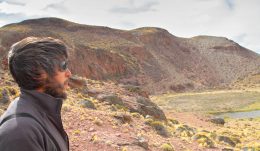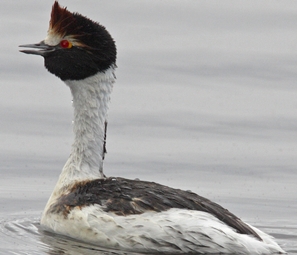Kini Roesler
The Hooded Grebe is a critically endangered species living in Argentina and it is number 21 on the EDGE bird list. Its long isolation made it become one of the most spectacular of all grebes in the world, both because of its plumage but also because of its social behaviour.
The historical isolation of this species has resulted in it becoming extremely adapted to a small set of crystal-clear lakes in the highlands plateaus of south-western Patagonia. Conservation efforts conducted at the breeding grounds, including trapping of predatory mink and removal of introduced trout, have been successful. Those efforts managed to stop the fast population decline that has eliminated over 80% of the global population. This management of invasive species and the protection of breeding colonies has been carried out over four seasons. This has resulted in the highest recruitment rate of juveniles seen during the last 40 years.
However, the Hooded Grebe migrates to the Atlantic Ocean. In wintertime they concentrate in just three estuaries, and in the last part of the winter the entire population concentrates in the Río Santa Cruz estuary. Through my fellowship the EDGE of Existence Programme is supporting my work on this species, trying to document its migratory routes and movement between different winter sites. The research is on track but now there are new threats ahead that make it even more important.
The Santa Cruz River was historically important as a natural dock. Even Sir Charles Darwin was studying this area during his voyage on the HMS Beagle. But the future of this pristine estuary is now being threatened. Construction of two mega hydroelectric dams is planned for the Santa Cruz River, no more than 150 km from the mouth of the estuary. There are no studies about the impact of the dams on the river and the estuaries. Research from dams all over the world has shown that they have a significant effect on nutrient cycles and water conditions, both upriver and downriver. An impact on the availability of water and the health of the invertebrate community may have a lethal impact on the global population of the Hooded Grebe. An impressive collaboration within Argentina has produced this stunning video describing the story of the dams and what is at stake. Watch and share widely!
With thanks to all contributors, including Aves Argentinas, FARN, Fundación Vida Silvestre Argentina, Banco de Bosques, Fundación Flora y Fauna Argentina and FUNAFU.
Related blog posts

Meet Kini Ignacio Roesler, our 2015 Hooded Grebe EDGE Fellow
Growing up in the Buenos Aires province of Argentina, provided me with easy access to some of the world’s most incredible natural environments. This…

Life on the EDGE: May-June 2015
Welcome to Life on the EDGE, our monthly blog featuring news about our projects, fellows, species, and all other things EDGE. This is our…

EDGE Fellows visit London!
This September, the EDGE of Existence team are looking forward to hosting 7 EDGE Fellows from our 2015-2017 cohort. They will attend a two…
